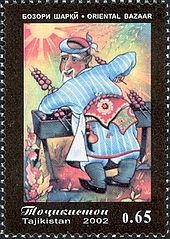샤슬릭
Shashlik 돼지고기를 토마토 주스, 양파, 식초, 레드와인에 재운 러시아 전통 샤슬릭. | |
| 코스 | 메인 코스 |
|---|---|
| 원산지 | 코카서스, 동유럽, 중앙아시아[1] |
| 서빙 온도 | 더워요 |
| 주요 성분 | 고기, 양념, 양파 |
샤슬릭(Shashlik)은 시쉬 케밥과 비슷하거나 동의어로 꼬치에 꿰어 구운 육면체 요리이다.그것은 전통적으로 코카서스, 동유럽,[2][3] 중앙아시아에서 다양한 이름으로 알려져 있으며, 19세기부터 러시아 제국의 대부분과 오늘날 러시아 연방과 옛 소련 [1][4][5]공화국들에서 샤슬릭으로 인기를 끌었다.
어원과 역사
샤슬릭 또는 샤슬릭이라는 단어는 투르크어에서 [6]유래한 러시아 샤슬릭에서 유래했다.터키어에서 쉬쉬라는 단어는 꼬치를 의미하고 쉬슬릭은 문자 그대로 "skewerable"로 번역됩니다.이 단어는 크림 타타르어에서 유래되었다: "쉬쉬" (스파이트)는 자포로즈 코사크족에 의해 만들어졌고 18세기에 러시아어로 들어갔으며, 그곳에서 [2][3][7]영어와 다른 유럽 언어들로 퍼져나갔다.그 전에 꼬치로 요리한 고기를 뜻하는 러시아 이름은 vertel에서 유래한 vertchenoye였다.[3]샤슬릭은 19세기 [8]후반까지 모스크바에 도착하지 않았다.그 이후로, 그것의 인기는 빠르게 확산되었다; 1910년대까지 그것은 상트페테르부르크 식당에서 주요 음식이 되었고 1920년대까지 그것은 이미 러시아 도시 전체에 널리 퍼진 길거리 음식이었다.
준비

샤슬릭은 원래 양고기로 만들어졌지만, 오늘날에는 지역의 선호와 종교적 [1][9]관습에 따라 돼지고기, 쇠고기, 사슴고기로도 만들어집니다.꼬치에 고기만 넣거나 피망, 양파, 버섯, 토마토 등 고기, 지방, 야채를 번갈아 넣거나 둘 중 하나다.이란 요리에서는 보통 샤슬릭용 고기가 큰 [10][11]덩어리로 되어 있고, 다른 곳에서는 중간 크기의 육면체 형태가 유지되어 브로셰트와 비슷합니다.고기는 식초, 드라이 와인 또는 신 과일/채소 주스와 같은 고산도 양념에 양파, 허브 및 [12][better source needed]향신료를 첨가하여 하룻밤 재운다.
오늘날 레스토랑 메뉴에 올라 있는 샤슬릭을 보는 것은 드문 일이 아니지만, 많은 지역에서 나무, 숯, 석탄 위에 꼬치를 올려놓고 굽는 노점상들에 의해 패스트푸드 형태로 더 많이 팔린다.그것은 또한 영어권 국가의 바비큐와 유사하게, 사교 모임에서 야외에서 요리됩니다.
「 」를 참조해 주세요.
레퍼런스
- ^ a b c Kraig, Bruce; Taylor Sen, Colleen (9 September 2013). Street Food around the World: An Encyclopedia of Food and Culture: An Encyclopedia of Food and Culture. ABC-CLIO. pp. 64, 294–295, 384–385. ISBN 9781598849554 – via Google Books.
An ancient dish, well known to herders and nomads across a wide swath of the Caucasus and Central Asia, shashlyk became popular in Russia in the mid-19th century after Georgia, Azerbaijan, and part of Armenia were absorbed into the Russian Empire. In those regions, shashlyk originally referred to cubes of grilled lamb cooked on skewers, whereas basturma was the grilled beef version of this dish. But Russians have broadened the term shashlyk to mean any kind of meat–pork, beef, lamb, venison–cut into cubes, marinated for several hours, threaded onto skewers, and cooked over hot coals.
- ^ a b Pokhlebkin, William Vasilyevich (2004) [1978]. Natsionalnye kukhni nashikh narodov (Национальные кухни наших народов) [National Cuisines of Our Peoples] (in Russian). Moskva: Tsentrpoligraf. ISBN 5-9524-0718-8.
- ^ a b c Culture and Life. Union of Soviet Societies for Friendship and Cultural Relations with Foreign Countries. 1982 – via Google Books.
The Russian term, shashlik, has an interesting etymology: it would seem natural for the word to be borrowed from one of the Caucasian languages. But no, the Georgian for it is mtsvadi, the Azerbaijani, kebab, and the Armenian, horovts. Shashlik is a Zaporozhye Cossack coinage from the Crimean Tatar sheesh (spit), brought to Russia in the 18th century, after Field-Marshal Mienich's Crimean campaign. Prior to the 18th century, the dish was called verchenoye, from the Russian vertel, spit.
- ^ Davidson, Alan (2014). Jaine, Tom (ed.). The Oxford Companion to Food. Oxford: Oxford University Press. p. 442. ISBN 9780191040726 – via Google Books.
- ^ Albala, Ken (2011). Food Cultures of the World Encyclopedia. ABC-CLIO. pp. V3:51, V4:35, V4:304. ISBN 9780313376269 – via Google Books.
- ^ 미국 유산 사전 엔트리: 샤슬릭
- ^ "Vasmer's Etymological Dictionary". starling.rinet.ru. Archived from the original on 16 January 2008. Retrieved 10 May 2017.
- ^ 츠요시1926년(블라디미르 길야롭스키).모스크바와 모스크바 시민. 1926년)
- ^ 입력: в. п. п. п. п. п, к. ,. м. м, ,, ,, ,, ,, ,, ,, ,, ,, ,, ,, ,, ,, 2000.모스크바, 첸트르폴리그라프, 2000, 러시아어)
- ^ "Archived copy". Archived from the original on 2013-10-12. Retrieved 2013-10-12.
{{cite web}}: CS1 maint: 제목으로 아카이브된 복사(링크) - ^ "Archived copy". Archived from the original on 2013-10-12. Retrieved 2013-10-12.
{{cite web}}: CS1 maint: 제목으로 아카이브된 복사(링크) - ^ Russland Journal의 샤슬릭 마리네이드 레시피.데





